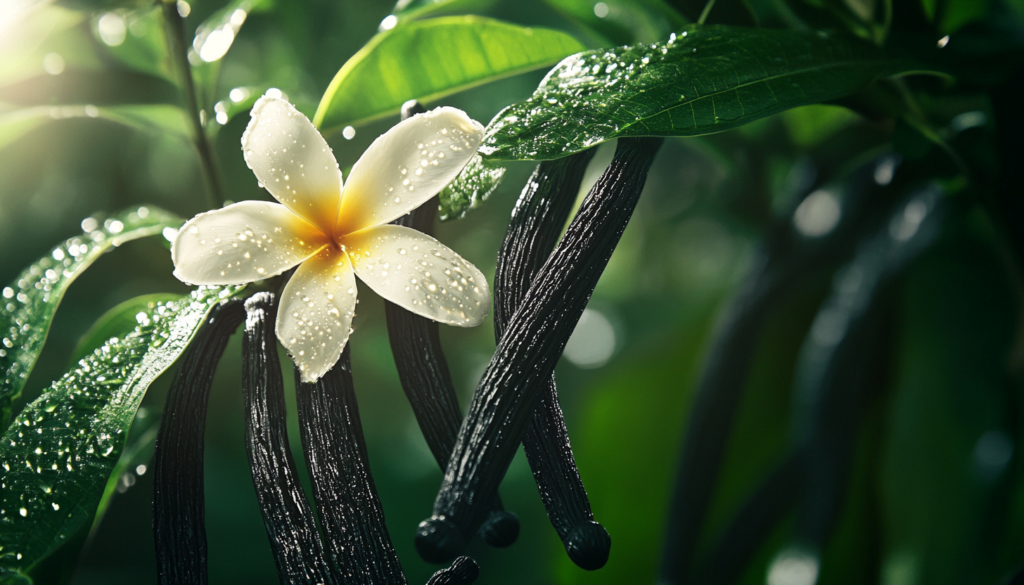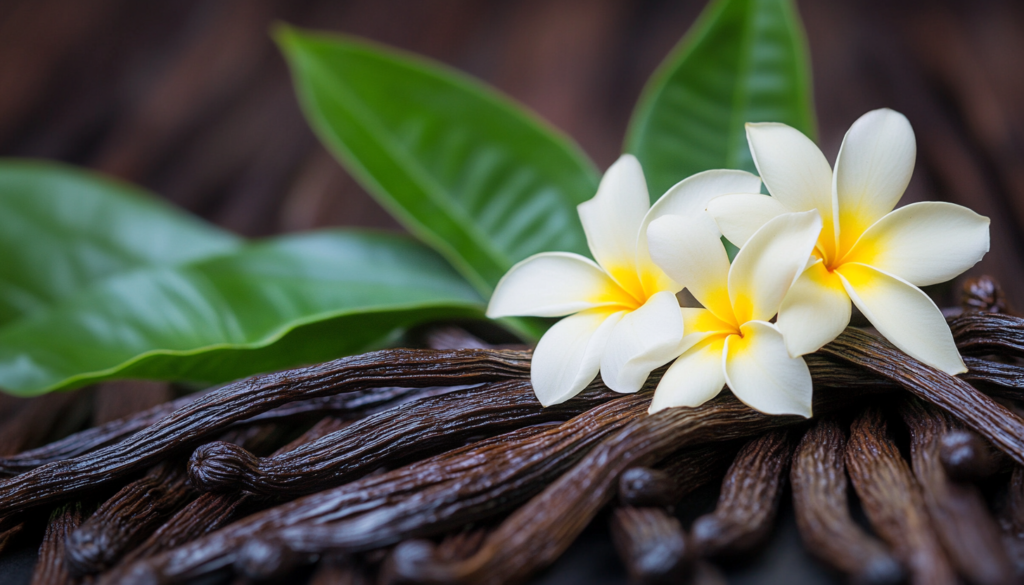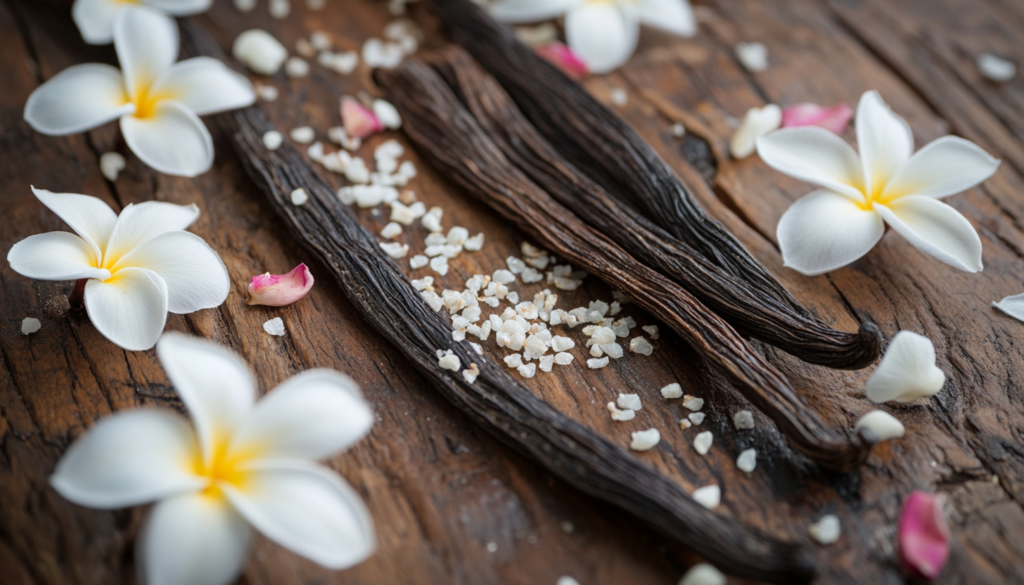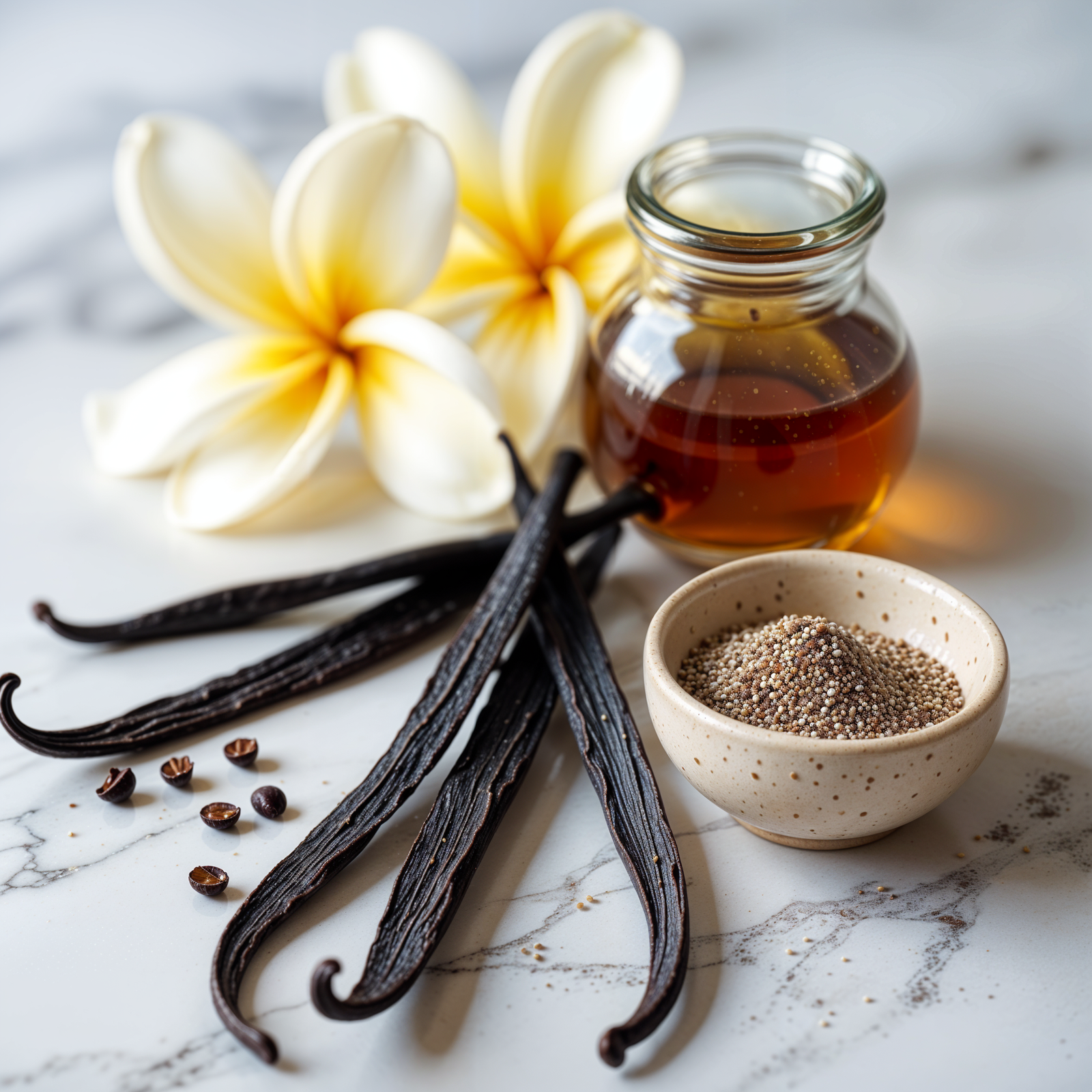Vanilla brings to mind warmth, sweetness, and comfort. It’s a key ingredient in kitchens around the world. It adds depth to many dishes, like cakes, cookies, custards, and sauces. Vanilla beans come from the Vanilla orchid and are a treasure in cooking.
They have a deeper and more complex taste than vanilla extract. You’ll find subtle floral notes and a touch of sweetness. To use vanilla beans, you must extract the tiny black seeds inside the pod. These seeds are packed with flavor.

Key Takeaways
- Vanilla beans provide a more intense and complex flavor compared to vanilla extract.
- The tiny black seeds within the vanilla bean pod contribute to its powerful flavor.
- Vanilla beans are a natural and pure source of flavor, unlike some commercial extracts that may contain additives or artificial flavors.
- Organic vanilla beans are grown without the use of synthetic chemicals or pesticides, offering superior quality and health benefits.
- Proper storage of vanilla beans in a cool, dark place preserves their flavor and aroma.
The Enchanting World of Vanilla Beans
Vanilla beans come from the vanilla orchid, a plant native to Mexico. These pods are long and slender. They give us the vanilla flavor we all love. The Vanilla planifolia is the most grown type, and each pod is full of tiny black seeds called vanilla caviar. These seeds hold the unique vanilla aroma and taste.
Unveiling the Mystery Behind Nature’s Beloved Flavor
The process from orchid to bean is quite interesting. Vanilla orchids live in the tropics and need to be pollinated by hand since there are few natural pollinators. After pollination, the pods take about 8-9 months to grow. Then, they are harvested.
The curing process is key to the beans’ rich flavor. The beans go through steps like blanching, sweating, drying, and conditioning. This turns the green pods into the aromatic, dark brown beans we love.
From Orchid to Pod: The Cultivation Journey
Growing vanilla is hard work that needs patience and skill. The process from pollination to curing takes 6 to 9 months. The beans are checked three times before they reach the United States.
These beans can last about 2 years if kept vacuum-sealed. This shows how much care and effort growers put into bringing them to our kitchens.
“Vanilla is slightly less preferred than chocolate for connoisseurs in the United States, but it remains a beloved flavor that is versatile and widely used in both sweet and savory dishes.”
What Makes Vanilla Beans So Special?
Vanilla beans are famous for their unique flavor, thanks to a complex chemical process. At the core, vanillin and piperonal are key compounds. Together, they create the aroma and taste that make vanilla so loved.
The Chemistry of Vanilla Flavor Unveiled
Vanillin gives vanilla its sweet, warm taste. Piperonal adds a subtle, earthy touch, balancing the sweetness. This mix creates a unique flavor.
Vanilla beans have over 200 flavor molecules, making them special. These molecules give real vanilla its rich, complex taste. This is why vanilla beans are so valuable in cooking.
| Vanilla Bean Species | Key Flavor Characteristics |
|---|---|
| Planifolia | The classic vanilla flavor, with notes of caramel and chocolate. |
| Pompona | A more floral and fruity profile, with hints of citrus and berry. |
| Tahitensis | A unique, complex aroma with undertones of prune, tobacco, and spice. |
Vanilla beans look as good as they taste. The small, dark seeds inside add elegance to any dish. This makes vanilla beans a favorite for their looks and taste.

Exploring vanilla’s chemistry shows its depth and complexity. From the mix of key compounds to the variety in different beans, vanilla is fascinating.
Vanilla Beans vs. Vanilla Extract
I love baking and exploring flavors, and I’ve found that vanilla beans and vanilla extract are quite different. Vanilla extract is easy to use, but vanilla beans give a purer, richer flavor. This makes your cooking stand out.
Vanilla beans come from the vanilla orchid and are carefully grown and cured. They have a deep aroma and flavor that vanilla extract can’t match. If vanilla is the main flavor in your dish, like in custards or ice cream, using vanilla beans is a good choice.
| Vanilla Beans | Vanilla Extract |
|---|---|
| Derived from the vanilla orchid plant | Made by infusing vanilla beans in alcohol |
| Offer a more intense and nuanced vanilla flavor | Provides a more subtle and balanced vanilla taste |
| Can be used to make homemade vanilla extract | Convenient for everyday baking and cooking |
| Require more preparation, such as scraping and infusing | Easy to measure and incorporate into recipes |
Using vanilla beans gives you a richer, more authentic vanilla taste. The vanilla bean flavor is unmatched, and the tiny black specks it leaves behind add a special touch. For those who love the real taste of vanilla, using vanilla beans is a must.
“Vanilla beans are the gold standard for vanilla flavor, offering a depth and complexity that vanilla extract can’t replicate.”
Unlocking the Flavors: How to Use Vanilla Beans
Vanilla beans are key to making homemade vanilla extract. They add a rich, aromatic flavor to your cooking that store-bought extracts can’t match. To get the most out of them, learning how to scrape and infuse them is crucial.
The Art of Scraping and Infusing
Start by cutting the vanilla bean in half with a sharp knife. This reveals the tiny seeds inside, which you can then scrape out with the knife’s back. Add these seeds to your recipes, like baked goods, custards, and creams, for a strong vanilla taste.
But there’s more to do with the vanilla pod. Put it in milk, cream, or sugar and let it steep. This infuses the liquid with vanilla’s unique flavor. It’s a way to use every part of the bean.
Sustainable Practices: Reusing Vanilla Pods
Remember, a little vanilla bean goes a long way. You might need to use less than you would vanilla extract. Start with a small amount and adjust as needed to taste.
“One vanilla bean is equivalent to about three teaspoons of store-bought vanilla extract.”
Using vanilla beans, scraping them, and infusing with them can take your cooking to the next level. It also helps you use resources wisely by reusing vanilla pods. Discover the magic of vanilla and how it can transform your kitchen.

Culinary Magic with Vanilla Beans
Vanilla beans are a true treasure in the kitchen. They can make both sweet and savory dishes taste amazing. Their deep flavor adds a special touch to many recipes, from creamy custards to fragrant rice dishes.
Elevating Sweet and Savory Dishes
For baking, vanilla beans are essential. You need 3 to 4 beans for about 1 cup of vodka to make vanilla extract. Or, you can use the beans directly in your recipes. Vanilla beans have a stronger and more complex taste than vanilla extract. Their tiny black seeds add a lot to the flavor.
But vanilla beans aren’t just for desserts. They can also make savory dishes taste better. Try adding vanilla to a risotto or a braised meat dish for a unique flavor.
“Vanilla beans provide an unmatched depth of flavor that can’t be replicated by commercial extracts.”
Using vanilla beans means splitting the pod and taking out the seeds. It takes a bit more work than using extract, but it’s worth it. Vanilla beans can replace extract by adjusting the amount to what you like.
So, whether you’re making a rich crème brûlée or a savory sauce, use vanilla beans. Their pure flavor will make your dishes stand out and leave people wanting more.
Sourcing and Sustainability of Vanilla Beans
When looking for vanilla beans, it’s important to focus on sustainability and ethical sourcing. As a conscious buyer, I aim to support farmers who use responsible methods and treat workers fairly. By picking organic or fair trade vanilla beans, I get to enjoy great flavor and help communities involved in growing them.
The Sustainable Vanilla Initiative (SVI) is a big step forward. It has 28 members, making over 70% of global vanilla bean sales. The SVI is working to fix the vanilla market and support sustainable farming.
- SVI wants to increase the amount of sustainably grown and traceable vanilla beans by 2020. This will help improve the lives of at least 30,000 vanilla farmers.
- With groups like CARE, Catholic Relief Services, and the Malagasy government, the SVI is addressing problems like early picking, quality, and child labor in vanilla farming.
- Synergy Flavors, part of the SVI, ensures vanilla beans quality by testing them thoroughly. They work with suppliers who value traditional curing ways.
Supporting the SVI and picking sustainably sourced vanilla beans helps us all. It makes the vanilla industry better for producers and ensures we have this special flavor for a long time.
“Collaborative efforts have been made in improving sustainability and quality in vanilla production to address challenges like the boom-and-bust cycle in vanilla pricing and environmental concerns in the industry.”
Vanilla Bean Varieties and Their Nuances
Explore the world of vanilla bean varieties and their unique tastes. There’s more than just the standard vanilla. Discover the magic of Bourbon vanilla and Tahitian vanilla to take your cooking to the next level.
Bourbon Vanilla: The Classic Choice
Bourbon vanilla comes from Madagascar and is a top pick for many. It has a rich, creamy taste with hints of caramel, tobacco, and dark rum. This type of vanilla is great for many desserts, from cakes and ice cream to drinks.
Tahitian Vanilla: A Floral Twist
Tahitian vanilla beans are known for their light, fruity scent. They come from Tahiti and have a flavor that’s like orchids and ripe stone fruits. These beans are perfect for light desserts, adding a sweet and complex taste.
Each type of vanilla bean has its own special taste. This lets you try different flavors to match your dishes. Whether you like the deep taste of Bourbon vanilla or the light taste of Tahitian vanilla, there’s a vanilla bean for you.
vanilla beans
Vanilla beans come from the Vanilla orchid and are a wonder of nature. They are long and slender, filled with tiny black seeds that give vanilla its unique taste. Making vanilla beans involves a lot of work, turning green pods into the aromatic, dark brown beans we all love.
These beans add a special flavor to both sweet and savory dishes. They are much better than vanilla extract, making them a favorite in kitchens everywhere.
The journey of vanilla beans takes them from the rainforests of Madagascar to the hills of Mexico. They are carefully hand-pollinated, picked, and cured. This process brings out their deep, complex aroma, perfect for many dishes.
Premium-quality vanilla beans cost between $12.99 and $14.99 for different amounts. They are 5-6 inches long and have 28% to 33% moisture. This ensures a rich, buttery flavor. If stored right, these beans can keep their aroma for up to 2 years.
These beans are great for adding flavor to baked goods or exploring in savory dishes. They make any dish special. Discover the magic of vanilla beans and see how they can change your cooking.
“Vanilla beans are the embodiment of nature’s sweetest secret, a gift that elevates every dish it touches.”
Preserving and Storing Vanilla Beans
Preserving vanilla beans’ delicate aroma and flavor is an art. As a home cook, I’ve learned that storing them right keeps their quality high. Here’s how to keep your vanilla beans fresh and flavorful for a long time.
First, store your vanilla beans in a container that seals tightly, away from sunlight and heat. They should be kept in a spot with a temperature between 60°F and 85°F, with good air flow. Don’t keep them in the fridge, as cold can harm their quality.
Vanilla beans can last up to two years if stored right. But for the best taste, use them within 6 to 8 months of buying them. Open the container for 10 to 15 minutes every few weeks to keep moisture away and keep the beans soft.
Look for vanilla beans with vanillin crystals for the best quality. These crystals mean the beans are full of flavor. But, avoid beans with mold, which looks like a powdery or feathery stuff in different colors.
If your vanilla beans dry out, you can soak them in warm milk or water to rehydrate them. This trick can bring back their aroma and make them ready for your recipes.
With the right storage, vanilla beans can be a lasting part of your cooking. Learn to preserve this amazing ingredient and enjoy its rich flavors for many years.
“Properly stored vanilla beans can last up to a couple of years, but it’s advisable not to order more than what can be used within six months.”
The Versatility of Vanilla Beans
Beyond Baking: Exploring Savory Applications
Vanilla beans are not just for sweet treats. They can also make savory dishes taste better. Add them to rice pilafs, roasted vegetables, sauces, and marinades for a new flavor. Using vanilla beans in savory dishes can surprise your family and guests with new tastes.
Vanilla’s sweetness and floral notes go well with many savory foods. Add a vanilla bean to your rice or quinoa cooking liquid for a unique aroma. Roast carrots, parsnips, or Brussels sprouts with vanilla beans to highlight their natural sweetness.
Vanilla beans can also change the game in sauces and marinades. Simmer a vanilla bean in tomato sauce or pesto for a rich, velvety flavor. Mix vanilla beans with garlic, herbs, and citrus for a special marinade for meats or seafood before grilling or roasting.
There are many ways to use vanilla beans in savory dishes. Try different techniques and flavors to see the magic they add to your cooking.
Vanilla Bean Dessert Delights
Vanilla beans are stars in desserts, adding a rich flavor. They make creamy custards, silky ice creams, and decadent cakes even better. Vanilla bean desserts take your treats to a new level of luxury. Try vanilla bean recipes to enjoy their deep flavor and smooth texture.
Indulgent Recipes to Savor
Vanilla beans bring a complex taste with floral and smoky notes. They are full of antioxidants and vitamins, making them a better choice than refined sugars.
- Vanilla Bean Chia Pudding is a vegan and gluten-free treat packed with fiber, protein, and omega-3 fatty acids.
- Vanilla Bean Frozen Yogurt is made with Greek yogurt, honey, and vanilla bean seeds, offering protein and probiotics.
- Vanilla Bean Baked Pears are roasted with vanilla bean-infused maple syrup, creating a naturally sweet and aromatic dessert.
- Vanilla Bean Energy Balls provide a perfect balance of fiber, protein, and healthy fats and are naturally sweetened with dates and maple syrup.
- Vanilla Bean Overnight Oats are a creamy and satisfying breakfast choice after soaking rolled oats in plant-based milk and vanilla bean seeds.
- Vanilla Bean Smoothie Bowl offers a sweet and aromatic blend made with frozen banana, plant-based milk, and vanilla bean seeds.
- Vanilla Bean Nice Cream, a dairy-free and vegan ice cream alternative, is rich in fiber, vitamins, and minerals.
Enjoy the tasty and healthy desserts with vanilla beans. They offer a unique flavor and many health benefits.
The Artisanal Appeal of Vanilla Beans
I’ve always been drawn to the charm of artisanal vanilla beans. These special beans are made by small producers. They bring a unique flavor that mass-produced vanilla can’t match.
Gourmet vanilla beans stand out for their quality and care. They come from remote places and are cured slowly to bring out their best taste and smell.
| Artisanal Vanilla Bean Perfume | Vanilla Bean Extraction Process |
|---|---|
| Showcases meticulous, hands-on craftsmanship Captivating aroma from carefully selected beans Praised for its blissful longevity and depth | Extremely time-consuming, taking 7-80 lbs of beans per pound of seed Requires selecting high-quality vanilla beans Contributes to a rich, authentic aroma |
Enjoying an artisanal vanilla bean dessert or drink connects me to the earth and the people who made it. It shows that vanilla’s magic is in its taste and the effort put into it.
Supporting small vanilla bean makers lets us enjoy top-quality vanilla and celebrate its global story. It’s a journey I love, exploring one artisanal vanilla bean at a time.
“The enduring appeal of vanilla bean notes ensures that Vanilla Bean Perfume remains a timeless and cherished choice.”
Exploring the Global Impact of Vanilla
Vanilla beans have a big impact that goes beyond cooking. The global vanilla industry, mainly in Madagascar, helps the economies and lives of farmers. From small farmers to big traders, the trade of vanilla beans connects people worldwide. By choosing to buy ethically made vanilla, you help improve the lives of many.
The vanilla industry is changing, thanks to more demand for sustainable farming and new consumer tastes. More people are making their own vanilla extract at home. They want products that are good for the planet and fair to everyone involved.
| Global Vanilla Production Trends | 2023 | 2024 (Projected) |
|---|---|---|
| Sustainable Farming Practices | 45% | 55% |
| Demand for Traceability and Transparency | 65% | 75% |
| Expansion of Vanilla Use in Savory Dishes | 35% | 45% |
The vanilla trade is changing too, with new ways for consumers to see where their vanilla comes from. These efforts make the supply chain more open and fair. This means more people want ethically sourced vanilla beans, which is changing the industry.
Vanilla’s impact goes way beyond cooking. By choosing wisely, we can help the global vanilla production and support communities worldwide.
Conclusion
Vanilla beans show us the beauty of nature’s flavors. They start as orchids and become the vanilla we love. This journey is filled with dedication, craftsmanship, and a focus on sustainability.
For both chefs and home cooks, vanilla beans open up a world of flavors. They can make your baked goods better and add depth to savory dishes. Learning about different types of vanilla beans and how they’re made helps you appreciate their quality.
As we end our look at vanilla beans, I urge you to keep exploring in the kitchen. Look for the best Madagascar Bourbon-cured beans for their amazing taste. Enjoy their fresh texture and rich flavors to take your cooking to the next level. By doing this, you support the farmers who work hard to bring us these special beans.
FAQ
What are vanilla beans and where do they come from?
Vanilla beans are the fruit of the vanilla orchid, specifically the Vanilla planifolia variety. They are native to Mexico and need a tropical climate to grow.
How are vanilla beans cultivated and processed?
Growing vanilla is hard work. The vanilla orchid flowers are often pollinated by hand. The pods take 8-9 months to grow before they are picked.
The curing process is key. It includes steps like blanching, sweating, drying, and conditioning. This process helps develop the beans’ rich flavor.
What gives vanilla beans their unique flavor profile?
Vanilla beans have special chemical compounds like vanillin and piperonal. These give them their unique aroma and taste. The seeds inside the pod are very aromatic and add beauty to dishes.
How do vanilla beans differ from vanilla extract?
Vanilla beans have a purer and more intense vanilla flavor than vanilla extract. The natural oils and compounds in the beans give a depth that extracts don’t. This makes them a top choice for recipes where vanilla is the main flavor.
How can I use vanilla beans in my cooking and baking?
To use vanilla beans, cut them lengthwise and scrape out the tiny seeds with the back of a knife. Add these seeds to your recipes for a burst of vanilla flavor. You can also add the used pod to milk, cream, or sugar to infuse flavor.
What are some of the different varieties of vanilla beans?
There are many types of vanilla beans, each with its own unique flavor. Bourbon vanilla from Madagascar is known for its classic, rich, and creamy taste. Tahitian vanilla beans have a more floral and fruity aroma.
How should I store and preserve vanilla beans?
Keep vanilla beans fresh by storing them in an airtight container in a cool, dark place. Don’t expose them to direct sunlight or heat, as this can dry them out and reduce their flavor.
Can I use vanilla beans in savory dishes?
Yes! Vanilla beans are great for savory dishes too. They can add depth and complexity to everything from rice pilafs and roasted vegetables to sauces and marinades.

